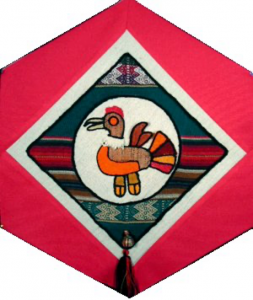Bolivia

The Block
A stylized condor in colourful wools dominates the centre of the Bolivia block, created through the cooperative efforts of Norma Greenhouse and Les Femmes de Bolivie. The Andean Condor, Bolivia’s national bird, represents power, strength, grandeur, freedom and health. Natural dyes were used to colour the Bayeta de la tierra fabric, which was hand-woven from 100 percent lamb’s wool. The pattern is a traditional design associated with Tiawanacu, the capital of the Aymara civilization.
Bolivia has a heritage of weaving excellence dating back to Pre-Incan times. Each geographical region of the country has its own colour combinations, motifs and finishing touches that have been used for thousands of years. In some areas, animals predominate, while others specialize in geometric patterns. For example, the Potolo region produces fascinating weavings displaying figures and animals from the mythical underworld, while the Calcha region produces the emblematic large striped pieces used to make ponchos.
This handcraft, historically important in many ways, (including as a means of survival against the cold, as payment of taxes, and as a means of creative expression) continues to play an integral part in Bolivian culture. Girls are taught to weave at a young age, enabling them to earn extra income for their families. Back-strap looms and horizontal and vertical looms are all used. This design, outlined in black wool, is embellished with a type of tassel used in many areas of Bolivia to adorn headbands, bags and belts, and a miniature jug, representing pottery, another significant art form in Bolivia.
Cultural Profile
Landlocked Bolivia, named after Simón Bolivar, is the highest and most isolated country in the Americas. Located in the west-central part of South America, its landscape consists of complex ecosystems and stunning scenery, including the Andes Mountains, the world’s highest navigable lake, Lake Titicaca, and highest ski resort, Mount Chacaltaya. Bolivia is also home to the largest indigenous population in the Americas, over half of whom maintain traditional lifestyles and beliefs. Spanish is the official language, and it is understood by 88% percent of the population. Many Bolivians also speak another language, due to their indigenous heritage. Quechua and Aymara are the most common ones, but there are 36 official languages recognized by the Bolivian constitution, a result of the country’s multiculturalism.
Bolivia’s culture is a blend of Spanish origins, due to Spain’s control over the country until its independence in 1825, and local indigenous cultures. This can be seen in the various festivals, such as the Carnival de Oruro and its famous diablada parade, where indigenous symbols and practices such as costumes, dances and customs, now serve as the basis for Christian religious holidays.
Bolivians, open-minded and independent by nature, value hospitality and personal contact and tend to have a relaxed view of time. They have a zest for life expressed in the many festivals celebrated annually and are known for their colourful masks and beaded, jewelled costumes. Other crafts include weaving blankets from alpaca and llama wool, pottery, and hat-making in a variety of styles, including chullos (ear-flap caps) and bowlers. The traditional dress of the ‘cholitas’, the indigenous women of the highlands, has become emblematic of the country: a pollera, a pleated skirt, a bowler hat, a manta (a shawl) and the aguayo, made of handwoven lama or alpaca wool tied around the shoulders and allowing the women to carry children or supplies. Each region and group of the highlands has its version of this traditional dress. Today, indigenous women have reclaimed it as a symbol of indigenous pride and resilience; cholitas have gone from rural to urban cool.
Immigration records indicate that Bolivians have been coming to Canada since 1974. They came in search of advancement and better opportunities, to join family members, or for educational purposes. Overcoming obstacles such as a language barrier and the weather, Bolivians integrated well into Canadian society while preserving their culture through such organizations as the Bolivian Association of Montréal, the Bolivian Association of Québec, Cercle Féminin Bolivien, and the Bolivian Association of Toronto. Bolivians have shared their love of music with Canada by introducing the haunting sounds of the zampoña (pan flute) and the charango (an instrument similar to a ukulele).
Sponsor: Gary Bryan, in memoriam Audrie & Kenneth Bryan
